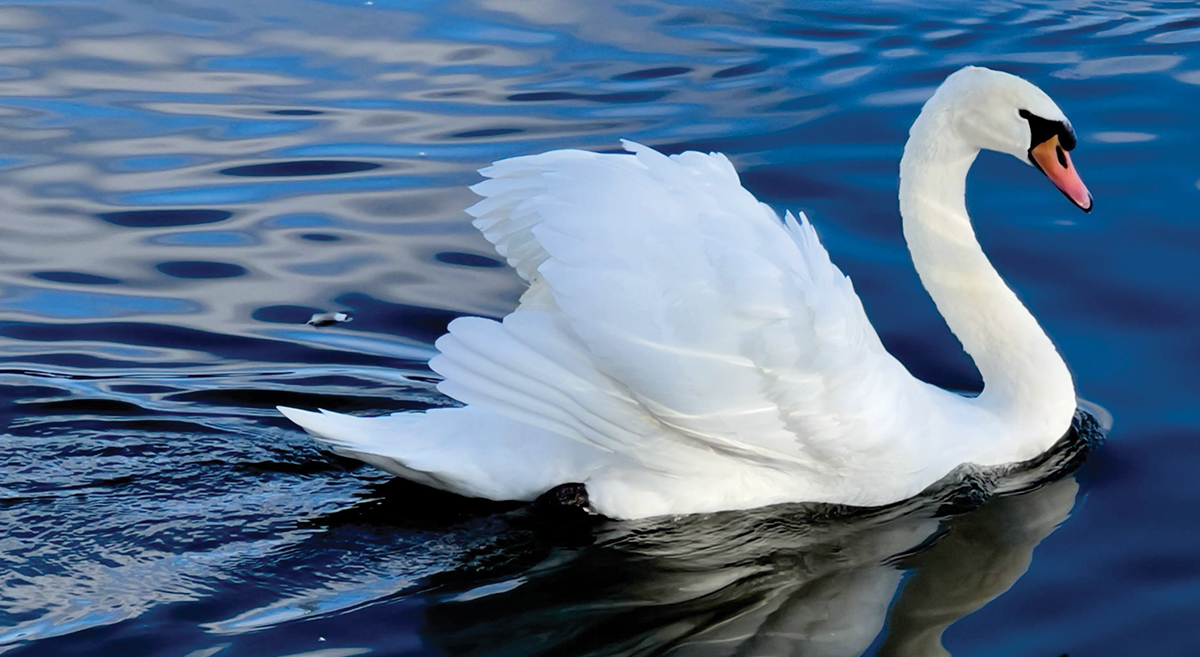
Photo by Holly Wilbur
Lake Junaluska’s Iconic Birds
By Paula Musto
Love. Elegance. Tranquility. Since ancient times, swans have symbolized these attributes. Once the preserve of royalty, these majestic waterfowl were first brought from Europe to America in the late 19th century to grace the grand estates of wealthy landowners. Today, we see them on lakes, ponds and rivers where they are much beloved by avian admirers. Perhaps, no more so than in Lake Junaluska, a waterside community 25 miles west of Asheville in Haywood County.
A flock (also known as a bevy) of 10 swans resides on the 200-acre lake cared for by Jackie Dingus and a team of more than a dozen volunteers. Dingus, known as the “Swan-Keeper,” and her team keep a watchful eye on their feathery charges, so much so that when two juveniles flew off to another lake in Buncombe County their visit was cut short when volunteers amassed a rescue party to bring the duo back. By all accounts Ken and Evelyn (all Junaluska swans have names) are happy to be home.
It’s not unusual for juvenile birds to spread their wings a bit, says Tom Tribble, past president of the Blue Ridge chapter of the National Audubon Society. Like teenagers everywhere, they are inclined to be adventurous.
The Junaluska swans belong to the exotic Mute species. With long-curved necks and distinctive orange beaks, they are the regal birds we know from Russian ballets and European fairy tales. Two other swan species—the Tundra and Trumpeter—are not often seen in Western North Carolina, according to Tribble, an avid birdwatcher who once spotted a solo Tundra near the bird sanctuary on Beaver Lake and a solo Trumpeter on the French Broad River. “I have no idea how they got here,” he says, “but they were a sight to see.”

Swan partners Ken and Evelyn. Photo by Peter Wilbur
There is a fourth species, the Whooper Swan, a Eurasian species that occasionally shows up in Alaska and has been seen in the US as far south as California, though rarely. To view large numbers of swans in the wild, Tribble suggests a visit to Lake Mattamuskeet, the largest lake in North Carolina located six hours east of Asheville. Thousands of migrating Alaskan Tundra swans hunker down there each winter.
“It’s quite a spectacle,” Tribble says. “Imagine thousands of swans all in one place. You are almost guaranteed to see them beginning in late November.”
Swan enthusiasts, however, can easily view the iconic birds on Lake Junaluska year-round—a whole lot closer and totally welcoming. The community’s well-groomed trails are open to the public and on any given day you will see residents and visitors alike, often with their dogs, walking the two- to three-mile loop around the lake.
Ken Howle, the executive director of Lake Junaluska Conference and Retreat Center, says more than a quarter million people each year visit the community that in addition to 850 homes includes a hotel and conference center in a bucolic setting overlooking the lake. Mornings and dusk are the best time to see the swans that tend to congregate near the foot bridge and boathouse on the east side of the lake.
“Swans capture the beauty of God’s creation,” Howle says. “We are happy to share the experience with others.”
With Valentine’s Day fast approaching, a visit might be a fun way to spend the day and see the romantic creatures that are among the most interesting in the avian kingdom. Here are some reasons why:
• Weighing up to 30 pounds, swans are giants among birds. Trumpeters are the largest of our native waterfowl and the heaviest flying birds in North America. Despite their heft, swans are expert aviators and glide swiftly in the air at speeds of up to 30 miles an hour.
• Devoted to their partners, swans mate for life and form monogamous bonds. In an impressive courting ritual, the male and female intertwine necks into a perfect heart shape, giving credence to their amorous reputation. Swans are known to grieve for dead mates or lost babies (which are called cygnets). Swans go through a mourning process and, it is said, they can die from heartbreak.
• Adult swans, both females and males, are highly protective of their young and will aggressively defend them when threatened: first by hissing a warning and, if unheeded, by chasing and attacking the predator. If you are lucky, in the spring you might see baby swans riding on their parents’ back.
Throughout history swans have left a sizeable mark on music, literature and traditions. We know them from childhood stories, certainly The Ugly Duckling, or fanciful tales from Greek mythology. Remember Zeus transforming into a swan to seduce his love interest Leda? In England, swans have been highly revered for centuries.
Legend has it that swans were introduced to the island in the 12th century when crusaders brought the exotic birds back from their campaigns. Throughout the Middle Ages, swans, which signified wealth and status, were a valued commodity traded by the nobility. Today, swans maintain their exalted status in Britain. Like royals before, Queen Elizabeth held the title Seigneur of the Swans, denoting the royal claim to all swans in the kingdom, a prerogative that now belongs to King Charles. Certainly, swans claim the hearts of admirers everywhere with their grace and beauty.
Paula Musto is a writer and volunteer for Appalachian Wild, a nonprofit whose mission is to help injured or orphaned wildlife. To help save wildlife, donate and learn more, visit AppalachianWild.org.







The swans are majestic as they glide along our lake and their Cygnets are so adorable. There are predators at the lake, however, so we are so grateful to our volunteers who check on them and care for them daily!
Thank you to Jackie Dingus and volunteers who take care of the swans. They enrich our lives.
Suzanne Cameron Hurley